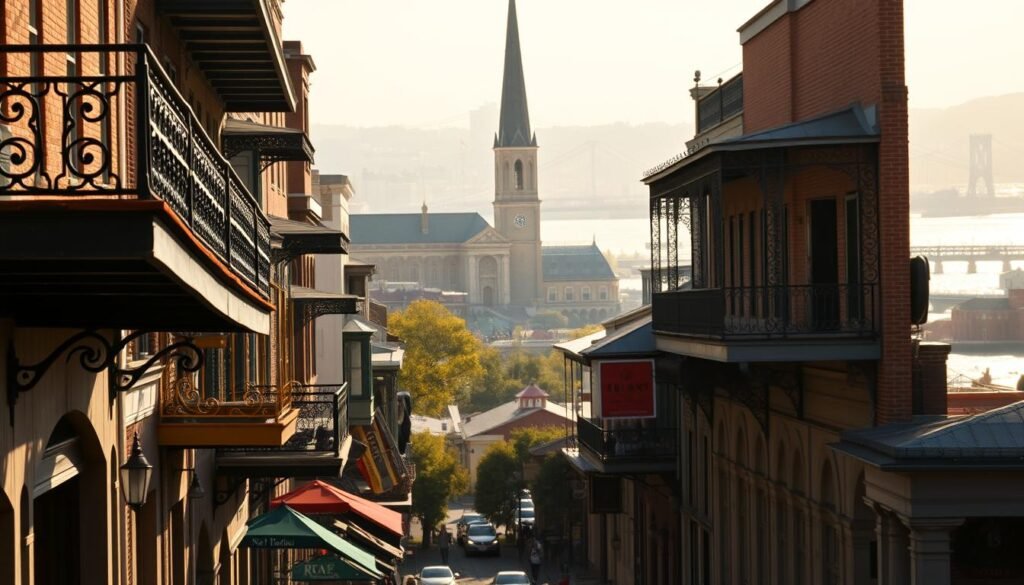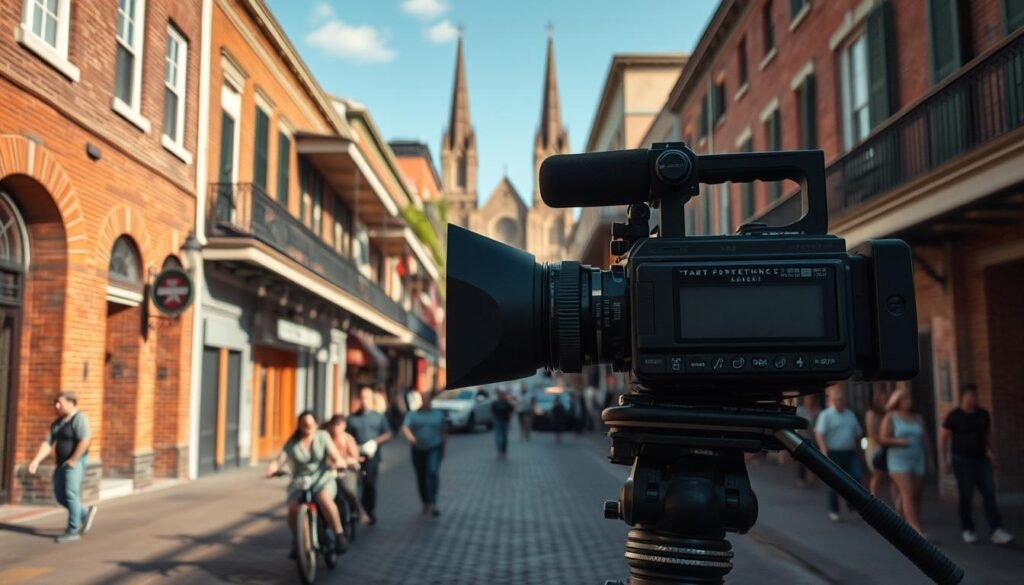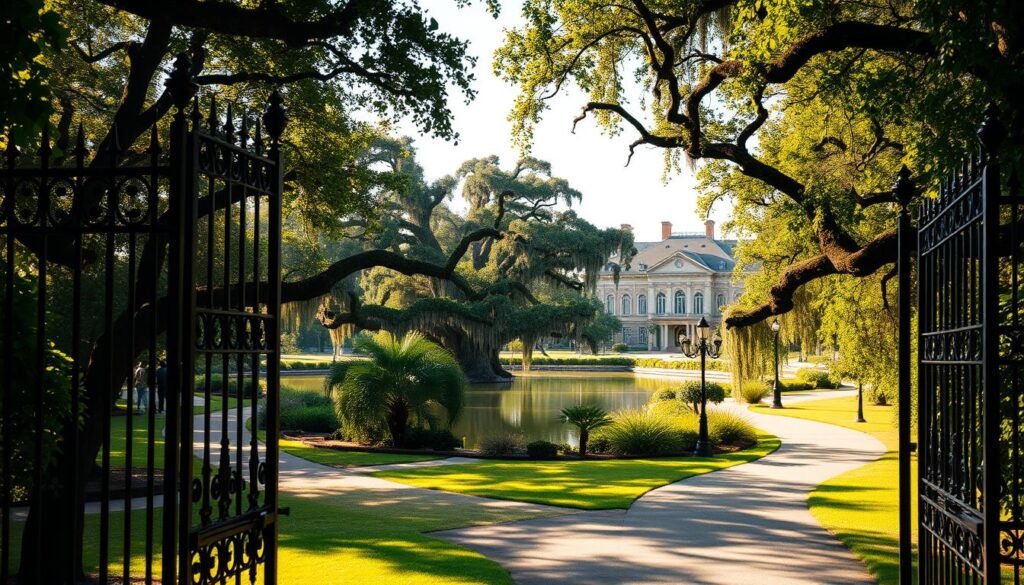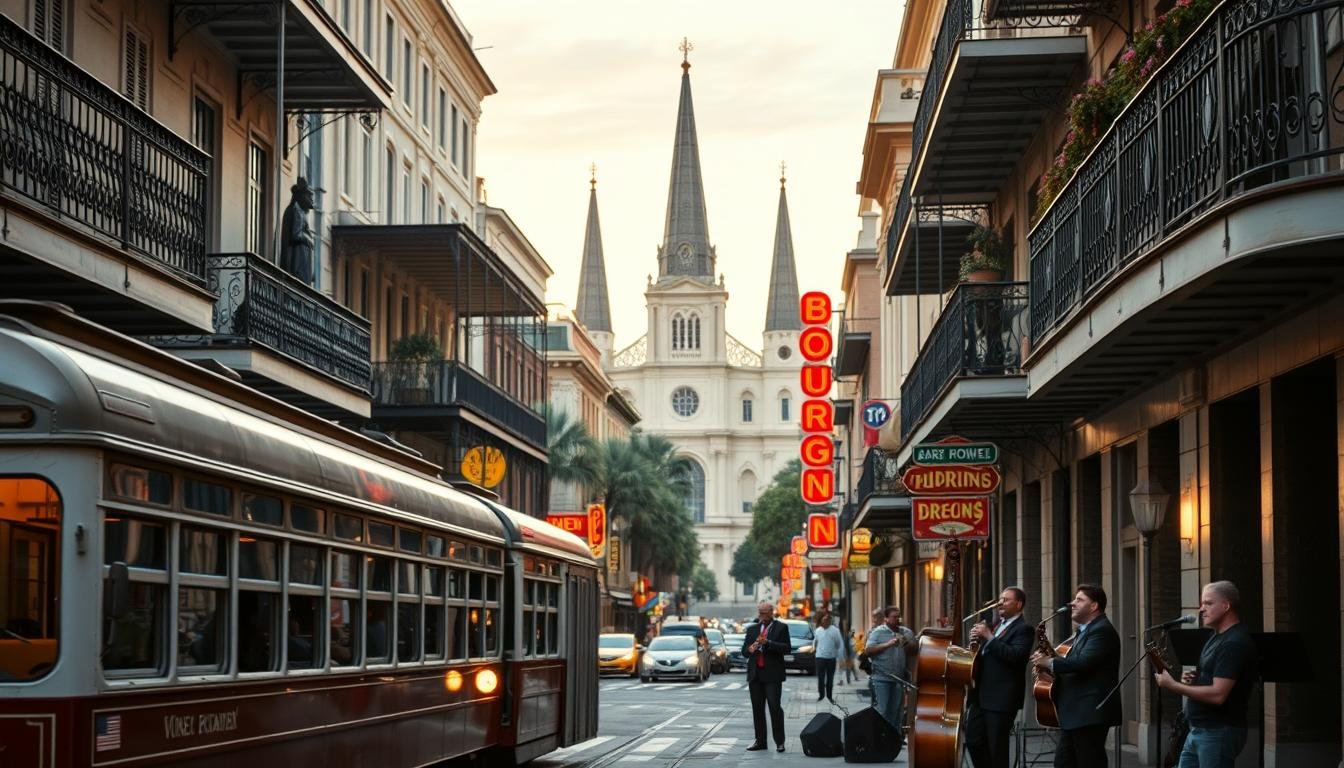As a local, I’m excited to take you on a journey through the city’s most iconic movie settings. New Orleans has been a cinematic star for decades, with its rich history, vibrant culture, and picturesque landscapes making it a filmmaker’s paradise.
From the historic French Quarter to the charming St. Charles Avenue, our city has been the backdrop for numerous films that have captivated audiences worldwide. I’ll share with you the most noteworthy movies filmed here and the scenic locations that make our city so unique.
As we explore these iconic film locations, you’ll discover the unique charm of New Orleans and why it remains a favorite among filmmakers.
Key Takeaways
- Discover the most iconic film locations in New Orleans
- Explore the city’s rich history in film and its significance
- Learn about the noteworthy movies filmed in New Orleans
- Uncover the scenic locations that make the city a filmmaker’s paradise
- Get an insider’s perspective on the city’s unique charm
The Rich History of New Orleans in Film
New Orleans has been a silent witness to the evolution of cinema, with its rich history in film dating back to the early 20th century. The city’s unique blend of cultures, architecture, and jazz heritage has captivated filmmakers, making it a popular location for shooting movies.
As a local, I’ve seen firsthand how New Orleans has been featured in numerous films, showcasing its charm and character. From the grandeur of its historic mansions to the vibrant energy of its streets, the city offers a diverse backdrop for storytelling.
How the City Captured Filmmakers’ Hearts
So, what makes New Orleans so appealing to filmmakers? For one, the city’s unique cultural heritage provides a rich tapestry of stories waiting to be told. The blend of French, Spanish, African, and American influences creates a distinctive atmosphere that’s hard to find elsewhere.
- The city’s historic architecture, with its grand mansions and ornate ironwork, provides a picturesque backdrop for period dramas.
- The vibrant energy of the French Quarter, with its jazz clubs and bustling streets, is perfect for capturing the essence of New Orleans’ famous nightlife.
- The city’s role in American history, particularly during the Civil War and the Civil Rights Movement, offers a wealth of material for historical dramas.
As noted on New Orleans’ official tourism website, the city has been a favorite among filmmakers for decades, offering a unique blend of culture, history, and entertainment.
A Brief Timeline of New Orleans in Cinema
New Orleans’ cinematic history spans over a century, with some notable milestones including:
- The early 1900s: New Orleans becomes a filming location for early cinema pioneers.
- The 1920s-30s: The city’s jazz scene is captured on film, showcasing its vibrant music culture.
- The 1950s-60s: New Orleans is featured in classic films like “The Buccaneer” and “A Streetcar Named Desire,” cementing its status as a cinematic gem.
Today, New Orleans continues to be a popular destination for filmmakers, with its rich history, cultural heritage, and movie magic making it an ideal location for shooting films. Whether you’re a film enthusiast or just a lover of the city, exploring the filming spots in New Orleans is a great way to experience its unique charm.
Noteworthy Movies Filmed in New Orleans
With its jazz-filled streets and historic architecture, New Orleans has become a character in its own right in many memorable movies. As a local, I’ve seen firsthand how the city’s unique charm has captivated filmmakers and audiences alike. From the grandeur of its antebellum mansions to the vibrant energy of its jazz clubs, New Orleans offers a cinematic experience like no other.

Oscar-Winning Films Set in the City
New Orleans has been the backdrop for several Oscar-winning films, showcasing its versatility and cinematic appeal. One notable example is The Curious Case of Benjamin Button, which not only won three Academy Awards but also highlighted the city’s unique architectural heritage. The film’s use of New Orleans’ historic landmarks, such as the Lafitte’s Blacksmith Shop, added to its visual grandeur.
Another significant film is 12 Years a Slave, although not exclusively set in New Orleans, utilized the city’s historic infrastructure for some of its pivotal scenes. The film’s success, including winning nine Academy Awards, further cemented New Orleans’ reputation as a premier filming location.
Cult Classics That Showcase New Orleans
Beyond Oscar winners, New Orleans has also been the setting for several cult classics that have become synonymous with the city’s cinematic identity. Interview with the Vampire, based on Anne Rice’s novel, is a prime example, with its dark, gothic atmosphere perfectly capturing the city’s mysterious side. The film’s use of St. Louis Cemetery No. 1 and other iconic locations has made it a favorite among fans of the vampire genre.
Another cult classic, The Big Easy, starring Dennis Quaid and Ellen Barkin, showcases the city’s more laid-back side, highlighting its jazz scene and the charm of its French Quarter. This film, among others, has contributed to New Orleans’ status as a beloved filming location, attracting filmmakers from around the world.
Famous Streets: The Backdrop of Filmmaking
New Orleans’ streets are more than just pathways; they’re the very fabric of our city’s cinematic identity. As a local, I’ve seen how our unique blend of history, culture, and energy has made our streets a favorite among filmmakers.
From the jazz-filled corners of the French Quarter to the grand antebellum mansions lining our historic avenues, every street in New Orleans tells a story. Let’s dive into two of the most iconic streets that have become staples in the world of filmmaking.
Bourbon Street: More Than Just Nightlife
Bourbon Street is synonymous with New Orleans’ vibrant nightlife, but its appeal goes far beyond the neon lights and jazz clubs. This street has been a filmmaking hotspot, offering a unique blend of energy and history that adds depth to any scene.
“Bourbon Street is like a character in itself,” says local filmmaker Jane Doe. “It’s got a pulse, a rhythm that’s hard to replicate elsewhere.”
From blockbuster movies to indie films, Bourbon Street has played a starring role in many productions. Its eclectic mix of old and new, coupled with the city’s permissive atmosphere, makes it an attractive location for filmmakers looking to capture the essence of New Orleans.

St. Charles Avenue: Charm and Elegance
In contrast to the lively Bourbon Street, St. Charles Avenue offers a more subdued, elegant backdrop for films. Lined with grand antebellum mansions, this avenue exudes a sense of history and sophistication.
St. Charles Avenue has been featured in numerous films and TV shows, often representing the epitome of Southern charm. Its picturesque scenery, complete with streetcars and oak trees, provides a visually appealing setting for period dramas and other productions.
| Street | Notable Films | Characteristics |
|---|---|---|
| Bourbon Street | The Hangover Part II, Project Power | Vibrant nightlife, eclectic architecture |
| St. Charles Avenue | The Originals, NCIS: New Orleans | Historic mansions, streetcars, oak trees |
Both Bourbon Street and St. Charles Avenue have become integral to New Orleans’ identity as a filming location. They offer a unique blend of culture, history, and visual appeal that continues to attract filmmakers from around the world.
The French Quarter: A Cinematic Gem
The French Quarter is a cinematic treasure trove, offering a unique blend of history, architecture, and culture that has captivated filmmakers for decades. As a local, I’ve seen firsthand how this area comes alive with its vibrant energy, making it a perfect backdrop for films.
“The French Quarter is like a character in its own right,” says local filmmaker, Jane Doe. “Its historic architecture, lively jazz scene, and vibrant nightlife make it an irresistible setting for stories.”
Iconic Spots for Film Lovers
The French Quarter is home to numerous iconic spots that have been featured in films. One of the most recognizable is Jackson Square, with its stunning St. Louis Cathedral. This historic park has been the setting for numerous movie scenes, from romantic comedies to horror films.
Another iconic spot is Bourbon Street, known for its lively nightlife and vibrant atmosphere. Filmmakers often capture the energy of this street during Mardi Gras celebrations, showcasing the city’s unique cultural heritage.
Why the Quarter Attracts Filmmakers
So, what makes the French Quarter so attractive to filmmakers? For one, its historic architecture provides a unique and authentic backdrop that is hard to replicate elsewhere. The area’s vibrant cultural scene, including its jazz music and lively street performers, adds to its cinematic charm.
“New Orleans is a city that’s always performing, and the French Quarter is the stage,” notes local actor, John Smith. “The energy here is palpable, and it translates perfectly onto film.”
The combination of these factors makes the French Quarter a go-to location for filmmakers seeking to capture the essence of New Orleans. Whether it’s a romantic drama or a horror film, this area has the charm and character that brings stories to life.
Scenic Locations: Parks and Historic Sites
From the grandeur of its historic sites to the beauty of its parks, New Orleans offers a diverse range of scenic locations that have captivated filmmakers. As a local, I’ve seen firsthand how these locations bring stories to life on the big screen.
Audubon Park: Nature Meets Film
Audubon Park, with its stunning oak trees and picturesque walking trails, has been the backdrop for numerous film scenes. The park’s natural beauty provides a serene contrast to the hustle and bustle of city life, making it an attractive location for filmmakers. As “a breath of fresh air in the heart of the city”, Audubon Park has been featured in various movies, showcasing its versatility as a filming location.

Jackson Square: A Picture-Perfect Setting
Jackson Square is another iconic location that has been featured in numerous films. The square’s historic architecture, lively street performers, and vibrant atmosphere make it a picture-perfect setting for movie scenes. As one of the most photographed places in New Orleans, Jackson Square has been immortalized on film, capturing the essence of the city’s charm. “The energy of Jackson Square is palpable, making it a favorite among filmmakers and locals alike.”
In conclusion, New Orleans’ scenic locations, such as Audubon Park and Jackson Square, offer a unique blend of natural beauty and historic charm that has captivated filmmakers. These locations not only showcase the city’s diverse landscapes but also contribute to its reputation as a premier filming destination.
The Haunting Atmosphere of New Orleans
As a local, I can attest that New Orleans has a certain vibe that draws horror filmmakers to its streets and landmarks. The city’s historic architecture, mysterious cemeteries, and cultural heritage create a unique ambiance that’s perfect for chilling scenes.
![]()
Horror Films and the City’s Vibe
New Orleans’ reputation as a haunted city is well-deserved, with its above-ground cemeteries and historic mansions providing a backdrop that’s both eerie and fascinating. Filmmakers have capitalized on this atmosphere, using the city’s unique vibe to create some of the most memorable horror movie scenes. The city’s blend of cultures, its jazz heritage, and its history of mysticism all contribute to an ambiance that’s both captivating and unsettling.
The result is a city that’s become synonymous with horror, attracting filmmakers who want to tap into that haunting atmosphere. From classic horror films to modern thrillers, New Orleans has played a starring role in many chilling tales.
Notable Scares Filmed in Local Landmarks
Some of the most iconic horror films have been shot on location in New Orleans, using the city’s landmarks to create truly terrifying scenes. For example, the LaLaurie House, once the site of a gruesome tragedy, has been featured in American Horror Story, leveraging its dark history to send shivers down viewers’ spines.
Other notable locations include the Congo Square, where the rhythmic beats of African drums have been immortalized in film, and the St. Louis Cemetery No. 1, a historic above-ground cemetery that’s become a character in its own right in numerous horror films. These locations, steeped in history and mystery, provide the perfect setting for horror filmmakers to craft their scares.
New Orleans continues to be a magnet for horror filmmakers, drawn by its unique blend of history, culture, and atmosphere. Whether you’re a fan of horror movies or just interested in exploring the city’s more macabre side, New Orleans offers a wealth of chilling experiences waiting to be discovered.
The Role of Mardi Gras in Movies
New Orleans’ Mardi Gras celebrations have been a cinematic goldmine, offering a unique blend of culture and revelry. The city’s ability to merge vibrant festivities with its rich history and jazz heritage makes it an irresistible setting for filmmakers.
Mardi Gras is more than just a party; it’s an experience that encapsulates the essence of New Orleans. The colorful parades, the rhythmic beats of jazz, and the elaborate costumes all come together to create a spectacle that is both captivating and cinematic.
Capturing the Spirit of the Festival
Filmmakers are drawn to the energy and authenticity of Mardi Gras. The festival’s unique blend of French, Spanish, and African cultures provides a rich tapestry that can be woven into compelling narratives. Movies like The Big Easy and Mardi Gras Mambo showcase the festival’s vibrant atmosphere, capturing the spirit of the celebration.
The use of Mardi Gras in films not only highlights the city’s cultural heritage but also adds a layer of excitement and unpredictability to the storyline. It’s not uncommon to see scenes featuring masked balls, jazz performances, and the elaborate floats that are synonymous with the festival.
Films Featuring Mardi Gras Celebrations
Several films have used Mardi Gras as a significant backdrop, including:
- The Princess and the Frog: An animated Disney film that beautifully captures the jazz and magic of Mardi Gras.
- Double Jeopardy: A thriller that uses the crowded streets of Mardi Gras to heighten the suspense.
- Mardi Gras Mambo: A documentary-style film that explores the history and cultural significance of Mardi Gras.
These films, among others, demonstrate how Mardi Gras can be used to enhance the cinematic experience, providing a unique and memorable setting that is quintessentially New Orleans.
In conclusion, Mardi Gras plays a significant role in movies filmed in New Orleans, offering a rich cultural backdrop that enhances the storytelling and captivates audiences. Whether it’s used as a central setting or as a colorful backdrop, Mardi Gras adds a layer of authenticity and excitement to films.
Behind the Scenes: Filming Challenges
New Orleans, with its rich history and cultural depth, has long been a favorite among filmmakers, but the city’s unpredictable weather and complex logistics can test even the most seasoned production teams. Filming here requires a blend of creativity, flexibility, and local knowledge.
Weather and Logistics in New Orleans
One of the biggest challenges filmmakers face in New Orleans is the weather. The city’s subtropical climate means hurricane season can be a significant concern, potentially disrupting shooting schedules. Moreover, the high humidity can affect equipment and crew comfort, necessitating careful planning and contingency strategies.
Logistically, navigating the city’s historic areas can be challenging due to narrow streets and crowded conditions. Permitting processes also require careful attention to detail to avoid delays. Some key logistical considerations include:
- Coordinating with local authorities for permits
- Planning for potential weather disruptions
- Managing the movement of crew and equipment through crowded areas
Working with Local Crews
Despite the challenges, many filmmakers find that working with local crews is a significant advantage. Local professionals bring invaluable knowledge of the area, from the best locations to the most efficient ways to navigate the city. This local expertise can be crucial in overcoming logistical hurdles and capturing the authentic essence of New Orleans.
Some benefits of working with local crews include:
- Their familiarity with local regulations and permitting processes
- Insights into the best times and places for filming to minimize disruptions
- Ability to suggest unique, lesser-known locations that add depth to the film
By combining local knowledge with careful planning, filmmakers can turn the challenges of filming in New Orleans into opportunities, capturing the city’s unique spirit on screen.
Tours for Film Enthusiasts
For movie buffs, New Orleans is a treasure trove of iconic new orleans movie settings waiting to be explored. The city’s cinematic history is not just about the films themselves, but about the places that brought those stories to life.
Guided Film Location Tours
One of the best ways to experience New Orleans’ film legacy is through guided tours. These tours are led by knowledgeable locals who can provide insights into the city’s filming spots in new orleans, from the famous to the obscure. You’ll get to visit locations that were pivotal in movies and TV shows, understanding the context and history behind each site.
Guided tours offer a wealth of information and often include behind-the-scenes stories and anecdotes that you wouldn’t discover on your own. They can range from general film location tours to specific themed tours, such as those focusing on horror movies or classic films.
Self-Guided Exploration Tips
For those who prefer to explore at their own pace, New Orleans is also a great city for self-guided film tours. With a little planning, you can create your own itinerary that covers the filming spots in new orleans that interest you most.
Start by identifying the locations featured in your favorite films or TV shows. Many resources are available online, including maps and guides that can help you plan your route. Consider the geography of the city and how to navigate between locations efficiently.
- Use a map or GPS to navigate between filming locations.
- Be mindful of private properties and respect any restrictions.
- Take your time and enjoy the city’s atmosphere and culture.
Whether you choose a guided tour or decide to explore on your own, New Orleans offers a unique cinematic experience that’s sure to captivate any film enthusiast.
Future Filmmaking in New Orleans
New Orleans continues to captivate filmmakers with its enchanting blend of history, culture, and visual appeal. As the film industry evolves, the city is poised to remain a major player, attracting creatives from around the world.
Emerging Trends Shaping the Industry
The film industry is witnessing a surge in diverse storytelling, and New Orleans is well-positioned to capitalize on this trend. With its rich cultural heritage and diverse landscapes, the city offers a unique backdrop for innovative storytelling, making it an attractive location for filmmakers seeking new and exciting settings among the best film locales in New Orleans.
A Growing Hub in Hollywood
New Orleans is increasingly becoming a hub for film production, with many productions choosing the city for its unique charm and logistical advantages. As the city’s reputation as a premier filming location grows, so does its influence in Hollywood, solidifying its position as a key destination for filmmakers exploring new orleans film locations.
FAQ
What are some of the most iconic film locations in New Orleans?
New Orleans has been the backdrop for numerous films, with iconic locations including the French Quarter, St. Charles Avenue, and Jackson Square. These areas have been featured in films like “Interview with the Vampire” and “The Curious Case of Benjamin Button.”
Can I take a guided tour of New Orleans film locations?
Yes, there are guided film location tours available in New Orleans, which can provide a wealth of information about the city’s cinematic history and take you to iconic filming spots.
What are some of the most notable movies filmed in New Orleans?
New Orleans has been the setting for many notable films, including Oscar-winning movies like “The Curious Case of Benjamin Button” and cult classics like “Interview with the Vampire.” Other notable films include “Mud,” “Django Unchained,” and “12 Years a Slave.”
Why is New Orleans a popular location for horror films?
New Orleans’ haunting atmosphere, historic architecture, and mysterious cemeteries make it a popular location for horror films. The city’s unique vibe has been used to create chilling scenes in numerous horror movies.
How has Mardi Gras been featured in films?
Mardi Gras has been featured in numerous films, capturing the spirit of the festival and showcasing the city’s vibrant culture. From colorful parades to lively parties, Mardi Gras has been used as a backdrop in films like “Angel Heart” and “The Big Easy.”
What are some tips for self-guided exploration of New Orleans film locations?
To explore New Orleans film locations on your own, start by researching the iconic filming spots and creating a list of the places you want to visit. Consider purchasing a map or guidebook to help you navigate the city, and be sure to take your time and soak up the atmosphere.
What are some of the best film locales to visit in the French Quarter?
The French Quarter is home to many iconic film locations, including Jackson Square, Bourbon Street, and the French Quarter’s charming streets. Be sure to visit these areas to experience the unique energy of the French Quarter.
How has the film industry impacted New Orleans’ economy?
The film industry has had a significant impact on New Orleans’ economy, bringing in revenue and creating jobs for local residents. The city’s film incentives have also attracted numerous productions, making it a hub for filmmaking.
